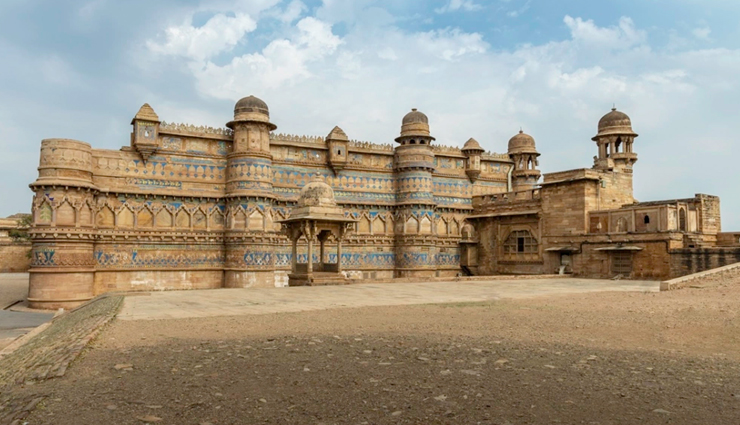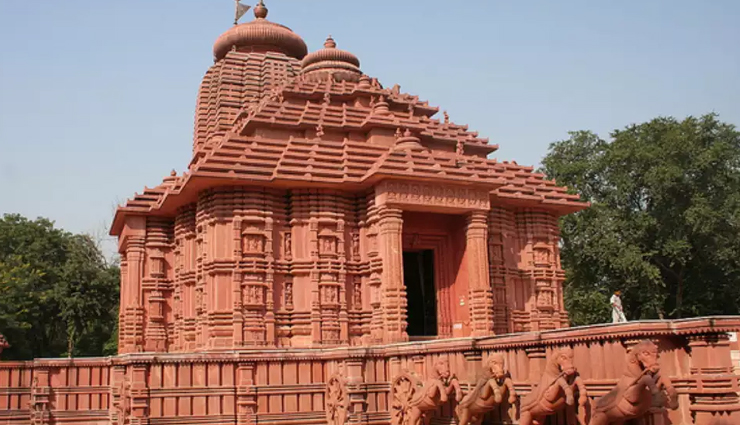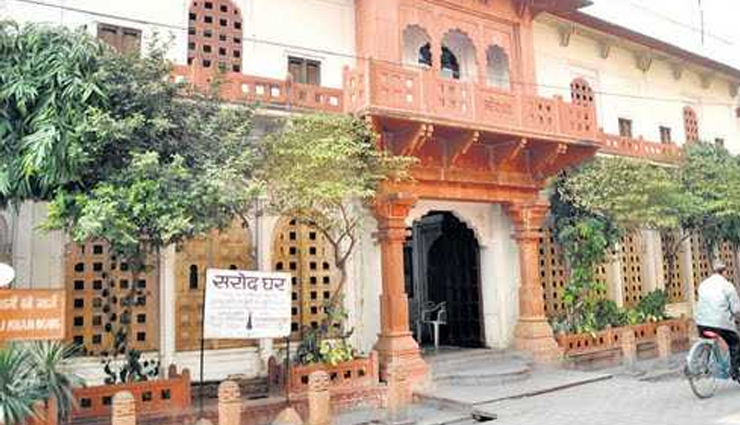18 Spectacular Places To Visit In Gwalior
By: Priyanka Maheshwari Wed, 05 July 2023 00:48:39

Gwalior, located in the state of Madhya Pradesh, India, is a city known for its rich history, architectural wonders, and cultural heritage. With its magnificent forts, ancient temples, and royal palaces, Gwalior offers a captivating journey into the past. If you're planning to visit Gwalior here are 18 must-visit places that will leave you mesmerized by their beauty and historical significance.

# Gwalior Fort
Gwalior Fort is a magnificent hilltop fort that stands as a testament to the grandeur of the past. This UNESCO World Heritage Site is known for its impressive architecture and historical significance. The fort dates back to the 8th century and has seen the rise and fall of various dynasties. It offers breathtaking views of the city and houses several palaces, temples, and other structures within its complex. The fort's massive walls, intricate carvings, and well-preserved architecture make it a must-visit destination for history enthusiasts and architecture lovers.

# Jai Vilas Palace
Jai Vilas Palace is a splendid palace that showcases a harmonious blend of European and Indian architectural styles. Built in the 19th century, it serves as the residence of the Scindia royal family. The palace is renowned for its opulence, exquisite design, and lavish interiors. It features grand halls adorned with chandeliers, antique furniture, and an extensive collection of artifacts. The Scindia Museum housed within the palace displays a fascinating array of treasures, including weapons, artworks, and rare antiques. The Jai Vilas Palace offers visitors a glimpse into the royal lifestyle and stands as a symbol of regal elegance in Gwalior.

# Sas-Bahu Temples
The Sas-Bahu Temples are a pair of ancient temples known for their exquisite architecture and intricate carvings. The temples, dedicated to Hindu deities Vishnu and Shiva, date back to the 11th century. Despite their name, which translates to "Mother-in-law and Daughter-in-law Temples," the Sas-Bahu Temples do not have any connection to the relationship between in-laws. The larger temple, dedicated to Lord Vishnu, showcases intricate carvings depicting various mythological scenes and divine figures. The smaller temple, dedicated to Lord Shiva, features an ornate entrance and intricate sculptures. The temples are a testament to the exceptional craftsmanship of the bygone era and provide a captivating glimpse into the rich cultural heritage of Gwalior.

# Teli Ka Mandir
Teli Ka Mandir is a remarkable temple known for its unique architectural style and towering height. Built in the 9th century, it is one of the oldest surviving structures in the city. The temple is dedicated to Lord Vishnu and stands out for its amalgamation of architectural influences, including North Indian, South Indian, and Indo-Aryan styles. The highlight of Teli Ka Mandir is its towering shikhara (spire), which reaches a height of over 100 feet. The intricate carvings on the exterior walls depict scenes from Hindu mythology, showcasing the exceptional craftsmanship of the artisans of that era. Teli Ka Mandir is a significant historical and religious site that attracts visitors with its impressive architecture and cultural significance.

# Man Singh Palace
Man Singh Palace is a stunning palace that reflects the architectural brilliance of the medieval era. Constructed by Raja Man Singh Tomar, the palace is known for its intricate designs, colorful tiles, and captivating frescoes. The palace showcases a blend of Rajput and Mughal architectural styles, creating a visually striking structure. The walls of Man Singh Palace are adorned with beautiful murals depicting scenes from mythology and Rajput history. The palace offers a glimpse into the royal lifestyle of the past and stands as a testimony to the artistic and cultural heritage of Gwalior. Visitors are enchanted by the vibrant beauty and artistic grandeur of Man Singh Palace.

# Gopachal Parvat
Gopachal Parvat is a picturesque hill known for its ancient rock-cut Jain sculptures. Nestled within the Gwalior Fort complex, Gopachal Parvat offers a serene and spiritual atmosphere. The hill is adorned with intricately carved statues of Jain Tirthankaras (spiritual leaders) and other divine figures. These sculptures, dating back to the 7th century, showcase remarkable craftsmanship and attention to detail. Visitors can take a leisurely walk along the hillside, marveling at the artistic beauty and cultural significance of the rock-cut sculptures. Gopachal Parvat is a significant pilgrimage site for Jains and a serene spot for anyone seeking solace amidst the tranquil surroundings and ancient artistry of Gwalior.

# Tomb of Tansen
The Tomb of Tansen is a historical monument dedicated to the renowned musician Tansen. Tansen was one of the nine gems (navratnas) in the court of Emperor Akbar and is considered one of the greatest musicians in Indian history. The tomb is situated in a tranquil garden known as Tansen Bagh and is a popular pilgrimage site for music lovers and followers of Hindustani classical music. The tomb is built in Mughal architectural style and is believed to be the final resting place of Tansen. The serene surroundings and the musical legacy associated with the tomb make it a significant cultural landmark in Gwalior. Visitors can pay their respects to the legendary musician and immerse themselves in the peaceful ambiance of the Tomb of Tansen.

# Suraj Kund
Suraj Kund is a beautiful stepwell that serves as a popular tourist attraction and a serene retreat. Surrounded by lush greenery and tranquil surroundings, this picturesque stepwell provides a refreshing respite from the hustle and bustle of the city. The name "Suraj Kund" translates to "Sun Pond," and it is believed to have been built during the 15th century. The stepwell features a series of descending steps leading to a large water reservoir. The architecture of Suraj Kund is characterized by intricate carvings and sculptures, adding to its aesthetic appeal. Visitors can enjoy the peaceful ambiance, relax by the water, and appreciate the architectural splendor of this ancient stepwell. Suraj Kund is a hidden gem in Gwalior that showcases the city's rich cultural heritage and natural beauty.

# Gujari Mahal Archaeological Museum
Gujari Mahal Archaeological Museum is a fascinating museum that houses a diverse collection of artifacts and sculptures. Originally a palace built by Raja Man Singh for his queen, Mrignayani, it was later converted into a museum in 1922. The museum showcases an impressive assortment of archaeological finds, including ancient sculptures, inscriptions, coins, terracotta artifacts, and more. The collection highlights the rich history and cultural heritage of the region, with exhibits dating back to the 1st century AD. Visitors can explore the museum's galleries, admire the intricate artwork, and gain insights into the historical significance of Gwalior. The Gujari Mahal Archaeological Museum is a treasure trove of art and history that offers a captivating journey through the bygone eras.

# Sun Temple
The Sun Temple is a modern architectural marvel dedicated to the Hindu sun god, Surya. Built in 1988, the temple is a significant religious site and a popular tourist attraction in Gwalior. The Sun Temple showcases a unique blend of contemporary and traditional architectural styles, with intricate carvings and exquisite craftsmanship. The temple's design is inspired by the famous Sun Temple of Konark in Odisha. It features a grand entrance, intricately carved pillars, and a magnificent sanctum dedicated to Lord Surya. The temple's serene ambiance and stunning architecture make it an ideal place for prayer, meditation, and spiritual contemplation. The Sun Temple is not only a religious landmark but also a testament to the artistic brilliance of modern temple architecture in Gwalior.

# Tighra Dam
Tighra Dam, situated near Gwalior is a picturesque reservoir and popular tourist destination. Built across the Sank River, the dam offers a scenic retreat for nature lovers and adventure enthusiasts. The vast expanse of water surrounded by lush greenery creates a tranquil atmosphere, perfect for relaxation and rejuvenation. Tighra Dam is a popular spot for boating, fishing, and water sports activities, attracting visitors from near and far. The serene surroundings and the panoramic views of the dam make it an ideal place for a picnic or a leisurely stroll. Whether you're looking for adventure or seeking solace in nature's embrace, Tighra Dam offers a delightful escape from the bustling city life of Gwalior.

# Moti Mahal
Moti Mahal is a historic palace that showcases architectural grandeur and regal elegance. Built in the 19th century, Moti Mahal served as the residence of the Scindia royal family. The palace derives its name from the exquisite pearl-like white marble used in its construction, which adds to its charm and allure. Moti Mahal features impressive halls, beautifully landscaped gardens, and intricate detailing that reflects the opulence and grandeur of the past. The palace offers a glimpse into the royal lifestyle and serves as a cultural landmark in Gwalior. Visitors can explore the palace's majestic interiors, admire the ornate decorations, and immerse themselves in the rich history and heritage of the region. Moti Mahal is a must-visit destination for those seeking to experience the splendor of Gwalior's royal past.

# Scindia School
Scindia School is an esteemed residential boarding school known for its commitment to academic excellence and holistic development of its students. Founded in 1897 by the Scindia family, the school holds a rich legacy and has maintained a reputation for producing outstanding scholars, leaders, and achievers. Spread over a sprawling campus, Scindia School offers state-of-the-art facilities for academics, sports, and extracurricular activities. The school follows a rigorous curriculum, combining academic rigor with a strong emphasis on character development, discipline, and moral values. Students at Scindia School receive a well-rounded education, participating in a wide range of activities such as sports, cultural events, and community service. The school's commitment to nurturing talent and fostering all-round development has earned it a place of distinction among the leading educational institutions in India.

# Kala Vithika
Kala Vithika is a cultural center dedicated to promoting and preserving the rich artistic heritage of the region. It serves as a platform for artists, performers, and craftsmen to showcase their talent and engage with the local community. Kala Vithika hosts a variety of cultural events, including musical concerts, dance performances, theater shows, and art exhibitions. The center also offers workshops and training programs to nurture artistic skills and encourage creativity among aspiring artists. Visitors to Kala Vithika can immerse themselves in the vibrant world of arts and culture, witnessing captivating performances and exploring the artistic creations on display. Kala Vithika plays a vital role in promoting Gwalior's cultural identity and providing a platform for artistic expression and appreciation.

# Sarod Ghar
Sarod Ghar is a museum dedicated to the renowned musical instrument, the sarod. This unique museum showcases the history, evolution, and significance of the sarod in Indian classical music. It was established by Ustad Amjad Ali Khan, a legendary sarod maestro, to preserve and promote the rich heritage of this stringed instrument. Sarod Ghar houses a remarkable collection of sarods, including rare and antique instruments, along with photographs, recordings, and artifacts related to the sarod and its maestros. Visitors can explore the museum's exhibits, learn about the instrument's craftsmanship and musical legacy, and gain a deeper understanding of Indian classical music. Sarod Ghar is a treasure trove for music enthusiasts, providing a unique opportunity to delve into the world of sarod and its contributions to Indian classical music.

# Gwalior Trade Fair
The Gwalior Trade Fair, held annually in Gwalior is a vibrant and lively event that brings together a diverse range of traders, businesses, and visitors from across the region. Also known as the Gwalior Mela, it is one of the most anticipated fairs in Central India. The fair showcases a wide array of products, including handicrafts, textiles, home décor, agricultural implements, and much more. It serves as a platform for local artisans, craftsmen, and entrepreneurs to exhibit their products and connect with potential buyers. The Gwalior Trade Fair is not only a hub for commercial activities but also a center of cultural exchange and entertainment. It features traditional music, dance performances, amusement rides, and delectable food stalls, adding to the festive atmosphere. The fair offers a unique blend of commerce, culture, and entertainment, making it a must-visit event for both business enthusiasts and those seeking a vibrant cultural experience.

# Gwalior Zoo
Gwalior Zoo, officially known as the Gandhi Zoological Park, is a popular attraction located in Gwalior. Established in 1922, it is one of the oldest zoos in India and spans across a sprawling area. The zoo is home to a diverse collection of animal species, including mammals, birds, reptiles, and amphibians. Visitors can explore the zoo's well-maintained enclosures and observe animals like lions, tigers, elephants, bears, crocodiles, and various bird species up close. Gwalior Zoo focuses on conservation efforts, education, and providing a safe habitat for the animals. The zoo also offers educational programs and awareness campaigns to promote wildlife conservation among visitors. It serves as a recreational and educational destination for families, nature enthusiasts, and animal lovers alike. Gwalior Zoo provides an opportunity to appreciate the beauty and diversity of wildlife while learning about the importance of conservation.

# Jai Vilas Palace Museum
Jai Vilas Palace Museum located in Gwalior is a magnificent palace-turned-museum that offers a glimpse into the opulent lifestyle of the Scindia royal family. Constructed in the 19th century, the palace showcases a seamless blend of European and Indian architectural styles, featuring grand halls, intricate carvings, and ornate interiors. The museum houses a vast collection of artifacts, including antique furniture, rare paintings, exquisite chandeliers, historic manuscripts, and a remarkable collection of weapons. One of the highlights of the museum is the stunning Durbar Hall, adorned with gold furnishings and adorned with crystal chandeliers, creating an awe-inspiring ambiance. Visitors can explore the opulent rooms and corridors, marvel at the royal treasures, and learn about the history and heritage of the Scindia dynasty. Jai Vilas Palace Museum is a captivating destination for history buffs, art enthusiasts, and those seeking to immerse themselves in the grandeur of a bygone era.





